Mechanics Institute Building
A Short History
(click here for the The Long and Interesting History of the Macclesfield Institute)
The Mechanics Institute, part of a state-wide educational movement, originally held meetings in the school room (now the RSL building). Its purpose was public instruction as well as social interaction, and it provided lectures on current events, literature and politics as well as a reading room and library.
It was from this small beginning that the enthusiasm came for the building of an Institute. Tenders were called for the Macclesfield Institute in October 1880. The successful builder was R.C. Trenouth of Strathalbyn with a basic price of £80 pounds. The building was designed at no cost by the Adelaide architect, F.W. Danker, a relation of the town’s storekeeper H. Danker.
The foundation stone of the Institute was a block of freestone with an inlaid marble panel, a gift from Mr Hugh Frazer, MP. On it was inscribed ‘Macclesfield Institute’. The stone was laid by A.H. Landseer MP, on December 16th 1880.
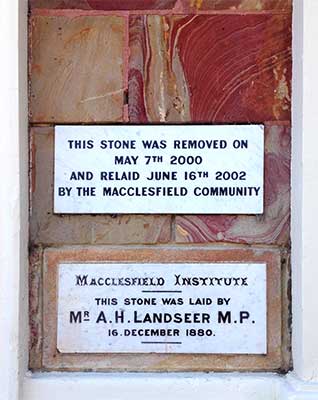
March 2015 (some graffiti removed digitally)
The Institute was formally opened on May 24, 1881, the Queen’s Birthday holiday. As reported in the local newspapers, Mr Landseer, after declaring the stone well and truly laid (loud cheers), said that he felt no doubt that the residents of Macclesfield would fully appreciate the advantages which such a building would give them, and now that they had men of culture settling amongst them, lectures for the benefit of the rising generation could be periodically given when the new Hall was open.
The opening day was marred by incessant rain which caused some modifications to the elaborate programme that had been planned. A large number of invitations had been sent out and at noon those who had arrived were warned to assemble for the opening ceremony by the firing of carronades. The Mount Barker Brass Band played in front of the building as the visitors assembled. Then Mr J.L. Stirling MP received the key from the Reverend J McMichael, said a few words to the assembly, opened the hall door and proceeded to the stage where the Institute Committee joined him. Several further speeches were made.
The Reverend McMichael outlined the financial situation thus: the purchase of the property and the total cost the building was £850; £90 had been paid for a piano and the cost of furnishing the hall had been about £60 making a total of £1,000. The receipts had been subsidised pound for pound by the Government and a mortgage of £500 had been secured.
An adjournment was made to the Davenport Arms where a public luncheon was provided. The local correspondent noted that a pleasing feature here was the presence of lady visitors.
Later in the day a reduced programme of sports were held on (the cricket ground) Davenport Square, there was a public tea in the schoolroom, and a grand opening concert in the Institute Hall at night, followed by a Ball.
A building which abutted the Institute was renovated and used as a supper room, reading room, library, kitchen and eventually, as the Council Chamber.
The minutes of the Institute Committee reveal that for the next hundred years the people of the town have gained enormous value from their hall. It has been used for dancing, lectures, skating, bazaars, square dancing, movie pictures, table tennis, concerts and numerous public meetings that have shaped the welfare of the district.
In 1891 the Macclesfield District Council took over control of the Institute and supervised its use through the agency of an elected Institute Committee.
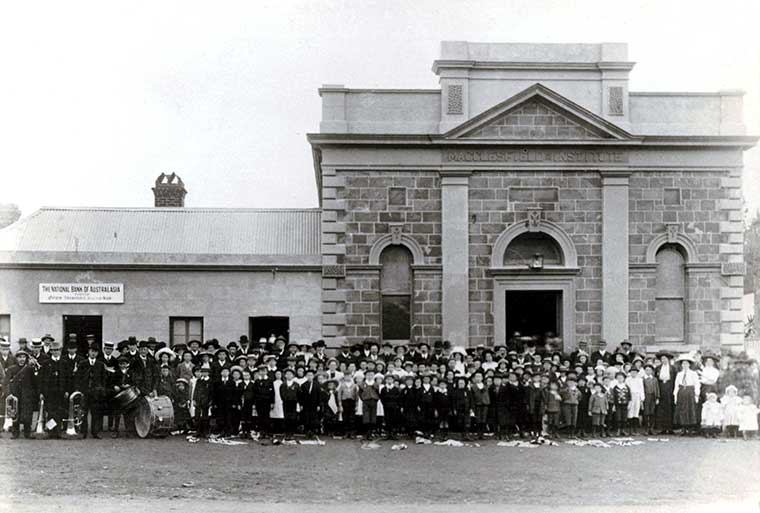
Above: The Macclesfield community celebrating the coronation of Edward VII and his wife Alexandra as King and Queen of the United Kingdom and the British Empire, on 9 August 1902. (photo courtesy B.Slack)
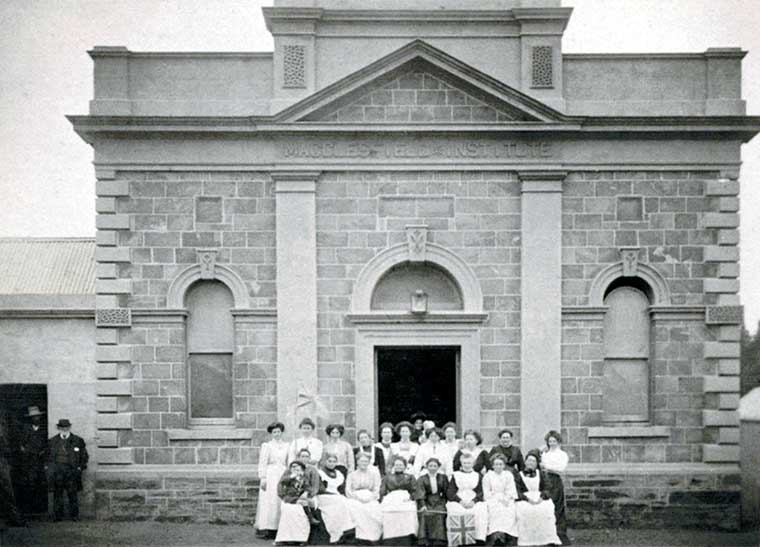
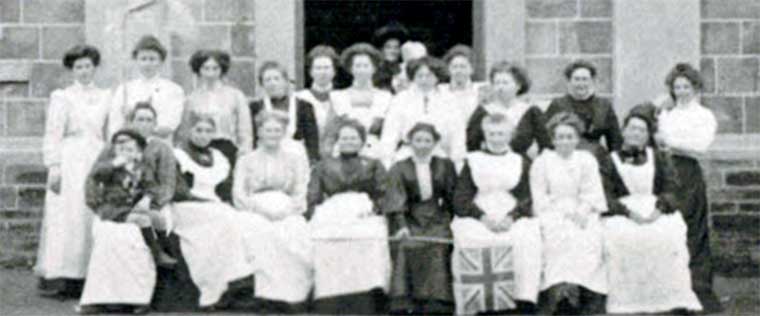
Above images: About 1915, the Macclesfield Red Cross ladies during World War 1.
Women have been at the forefront of the Red Cross since its foundation in Australia. In the days after the outbreak of World War I, the wife of the then Governor-General, Lady Helen Munro Ferguson, established the first branch (as part of the British Red Cross Society) in Australia, on 13 August 1914. She wrote to the wives of each State Governor to secure their support, and Red Cross branches were quickly formed in each state.
Australian women flocked to the cause. Red Cross enabled women to do something tangible for the war effort. During WWI, Red Cross formed the Voluntary Aid Detachments (VAD's) in Australia, based on the British Red Cross model. The vast majority comprised of women and girls, known as VAs, who were trained in first-aid and home nursing, to carry out unpaid domestic and quasi-nursing duties in hospitals and convalescent homes. They became the public face of Red Cross.
Women produced millions of pounds worth of in-kind support through volunteer labour and goods, sending an astonishing volume of goods overseas to servicemen and prisoners of war. They knitted and sewed socks, towels and vests for soldiers, much of the work done by hand in small rural communities where there was often no electricity. See www.redcross.org.au
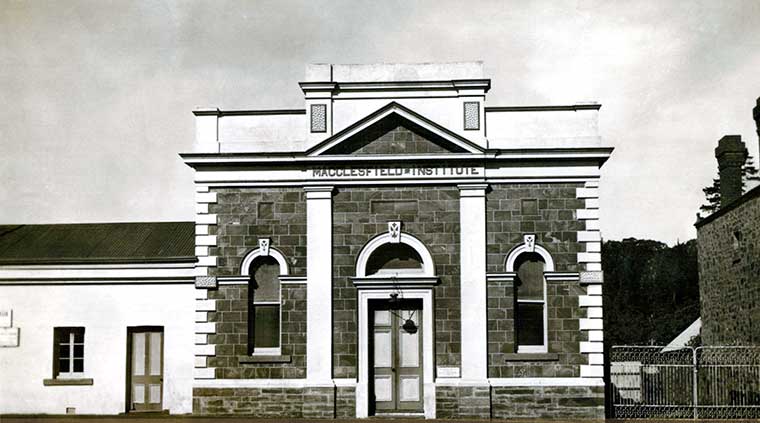
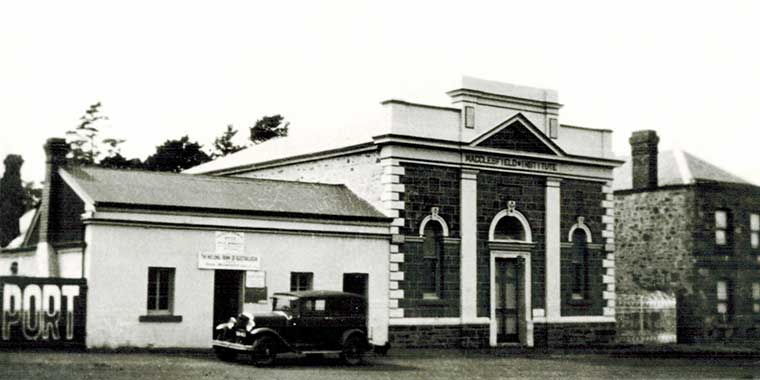
Above images: Macclesfield Institute in the 1940's
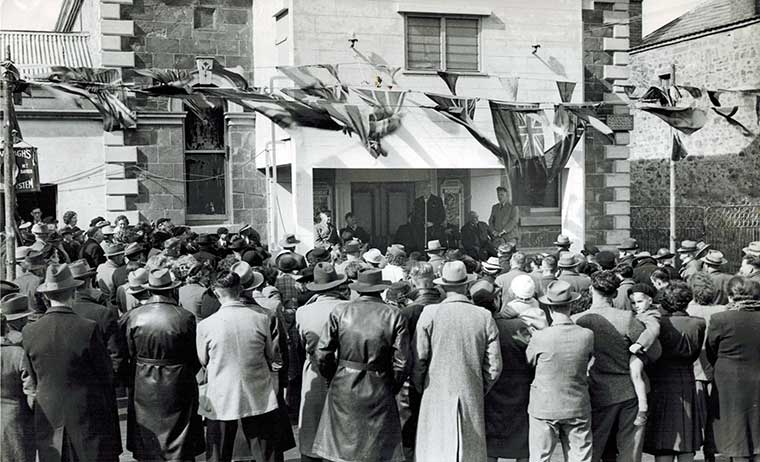
Above: Sir Roy Robinson speaking at the Institute in 1948
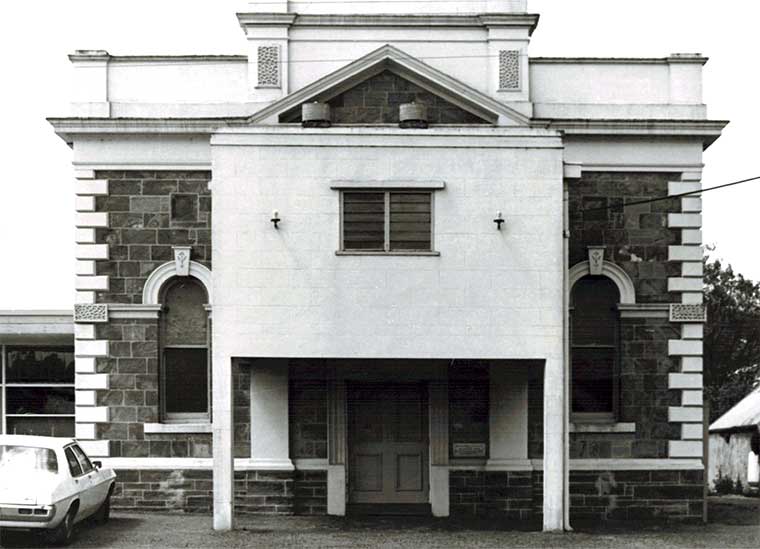
Above: The Hall with the Cinema Box addition to the front of the building. This was made when ‘Avon Pictures’ were operating in Macclesfield. It was removed in the 1980’s. Photo courtesy of L. Davis.
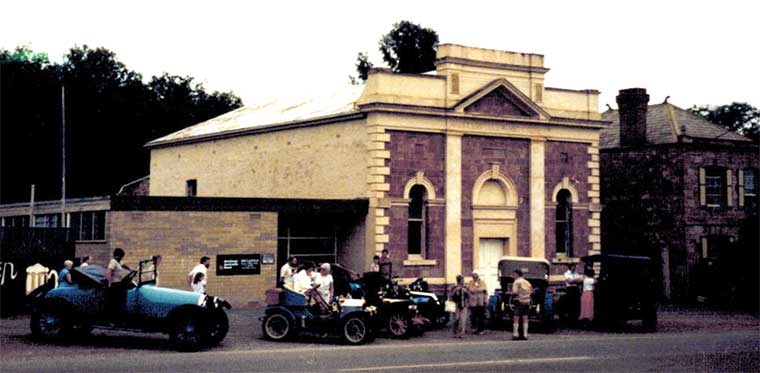
Above: Old cars in Venables Street 1986 (Photo courtesy W Springbett)
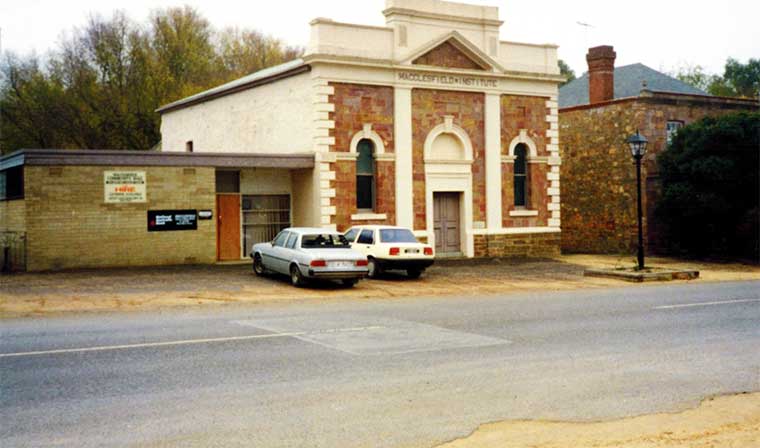
Above: The Institute in the 1990's, with new rooms and a lamp post.
The Long and Interesting History of the Macclesfield Institute
by Betty WHITE and Ray RISELY, in a Newsletter article spread over many issues.
In January 1880 a correspondent reported that “the Macclesfield Institute is now in a flourishing condition, a large room has been purchased in the Main Street as a Reading Room, and a Hall will be put up before long.” A Committee was elected, architect F W Dancker, a relation of H Dancker of Macclesfield, designed the building at no cost to the town, and tenders were called for the construction.
Out of six tenders, that of Mr Trenouth of Strathalbyn at 580 pounds was successful. The Mt. Barker Courier reported that “no time has been lost in getting on with the job, the contract being signed on Tuesday and on Wednesday morning active preparations were made for getting in the foundations. The building is to be completed within 4 months of the date of signing the contract.”
A little later, and, “On Thursday December 16th 1880, Macclesfield gave Public Notice that she meant to have a good time of it. On that day was laid the Foundation Stone of the Institute, which the liberality of her residents, aided by the untiring efforts of an energetic and intelligent Committee have enabled her to found, and which in a very short time, will be brought to completion. The proceedings connected with the laying of the stone were of a most satisfactory character, but before rendering an account of them, we will endeavor to give some idea of the building itself.
The style adopted is Italian, and the elevation of dressed free-stone quarried in the locality. It is surmounted by a pediment and cornice with the dressings in cement. The Hall will be of fine proportions, being 50 feet in length, 30 feet in width and 20 feet from floor to ceiling, which has a deep, curved cornice. At the end of the Hall will be an ornamental arched proscenium 14 feet wide in front of the stage, which will be 13 feet deep, and contains an ante room on each side. The Hall is lighted by 6 large windows, 7 feet above the floor. The perfect renewal of air has been amply provided for by the means of two large ornamental ventilators in the ceiling. It is expected that it will be completed by Easter.”
Rev. J C McMichael, President, having welcomed the residents to this all important occasion, said that the Macclesfield Institute had been connected to the South Australian Institute for about 16 years, and he was extremely pleased to find that the day had arrived for the laying of the foundation stone of a building which they might well be proud of. The people must have amusements, both social and intellectual and a Public Building would go far towards accomplishing this desirable end.
Mr. Marker, Hon Secretary, then read the following document:- “Macclesfield Institute. South Australia. This stone was laid by Mr. H Landseer MP, Snr Member for the electoral District of Mt. Barker on Thursday the 16th day of December in the year of Our Lord one thousand, eight hundred and eighty, in the forty fourth year of the Reign of Her Most Gracious Majesty Victoria, Queen of Great Britain, Ireland and Empress of India; Sir William Francis Drummond Jervois, Major General in Her Majesty’s Army, Knight Grand Cross of the Most Distinguished Order of St. Michael and St. George, Companion of the Most Honourable Order of the Bath, Governor and Commander-in-Chief, in and over the Province of South Australia and the Dependencies thereof , and Vice-Admiral of the same, the following being the Officers, Committee and Trustees of the above Institute viz; President Rev. J C McMichael; Vice President, Rev. W Prendergast; Hon. Treasurer, Mr. B P Conigrave; Hon. Secretary, Mr. H F Marker; Committee, Messrs. J Webb, J H Agar, Sen, H Conigrave, W H Dancker, G R Lowe, M Considine, J Cummins, and W Robinson. Trustees, Messrs. J H Marker , E D Davenport, H A Schmidt, J Cummins, T Wade, Architect Mr. F W Dancker; Contractor and Builder, Mr. R C Trenouth. This, together with copies of the Mt. Barker Courier, South Australian Register, Advertiser and Southern Argus, were placed in a bottle, which was subsequently put under the stone."
Mr. McMichael then handed a handsome silver trowel from Steiners establishment to Mr. Landseer and requested him to lay the stone. Mr. Landseer, after having seen the stone placed in its proper position, declared it to be well and truly laid to loud cheers from the crowd. He then gave a speech reflecting on the advantages such a Hall would give the residents, and congratulated the Committee who were carrying out such good work. He thanked them for the honour they had done him, and said he would always feel in being of service to them in any way in the future.
Rev. Fr. Prendergast thanked Mr. Landseer and declared that the Public Building should unite all the sympathies of the people, and he strongly advised them to be united in bringing this to a happy conclusion, and was roundly applauded.
The Rev. Mr. Harris then said he had had the pleasure of presenting 40 or so volumes to the Library when it was in a very humble position, and the building of an Institute showed that people did not always wish to be as they were, and if united in their efforts much good would be done for the town.
Mr. R Davenport of the Echunga Institute then read an address to those present.
The Company then adjourned to The Hotel where luncheon had been provided. After the usual Loyal toasts had been duly honoured, Mr. Conigrave proposed the Ladies, expressing his pleasure at seeing them present. He believed that generally speaking it was not usual for meetings of that kind to be graced with the presence of ladies, but this was not the first time they had been so honoured in Macclesfield and he felt that the Gentlemen present would probably appreciate the compliment so kindly paid to them. Rev. McMichael returned thanks and Rev. Fr. Prendergast proposed the health of the Chairman. The toast was drunk with musical honours.
A bicycle tournament took place in the afternoon, and after that various feats by the riders and their machines. These were very much admired and, being a novelty in the country, great interest was taken in the proceedings. A Tea Meeting was held in a large marquee erected for the occasion. Admission was 1/- (10c), the provisions being supplied by a number of residents. A concert by Adelaide people held in the large room at the Hotel was well attended, and most satisfactory. Front seats were 2/- (20c) and back seats 1/-, bringing to an end a very happy occasion. Proceeds from the day were about 50 pounds.
The building of The Institute continued to progress favourably and by May 1881 all was ready for the Official Opening.
“Tuesday the 24th of May was strictly observed as a public holiday, it being the birthday of Her Most Gracious Majesty. It was therefore taken advantage of by the Committee of the Macclesfield Institute, for the Opening of their new building with appropriate formality. The only anxiety was for the hope of a fine day, but this was not granted and it rained incessantly until 9 o’clock when it cleared a little, but not enough to encourage people living at a distance, to put in an appearance. ”
At mid-day the firing off of ‘maroons’ or ‘carronades’ was heard, which sound resembles that of a small cannon. This was the signal for the proceedings to commence with an overture by the Mt. Barker Brass Band, which also entertained during the afternoon. Mr. J L Stirling MP then arrived and after receiving the key from Rev. J C McMichael, he made a fitting speech then opened the door and proceeded to the stage where the Committee and other gentlemen took seats. Various congratulatory speeches were made and responded to and Mr Conigrave then called on the President to state the position of the Institute.
The purchase of the property and the cost of the contract was 850 pounds; 90 pounds was paid for the piano, and the cost of furnishings was 60 pounds, making a total of 1,000 pounds. Receipts were 180 pounds from subscriptions which Government subsidized pound for pound, and cash in hand 20 pounds. A mortgage for 500 pounds for 5 years had been effected at 8 percent. Mr. Stirling MP addressed the assembly noting that this was the first work of a public character he had undertaken since being elected representative of the District, and was pleased that it was connected with an object which would commend itself to all right thinking minds. It was the duty of everyone to help in the cause of education as far as they could, there was a gratifying increase in Institutes in South Australia, and it pointed to the fact that they were appreciated. He thanked those concerned for the honour bestowed on him and assured them of his interest in the welfare of their town etc,.
An adjournment was made to the Davenport Arms Hotel where a public luncheon had been provided. The health of the Queen was enthusiastically drunk, then followed those of the Prince of Wales, and Royal Family, and of the Governor, and a toast to the Parliament coupled with Mr. Stirling was drunk with musical honours. Mr. Stirling thanked them and proposed the Committee, and Mr. H Marker responded. Rev. Fr. Prendergast proposed the South Australian and Kindred Institutes and hoped that the entertainments provided by the Institute would be the means of enticing young people from the public houses which they were in the habit of attending at present. Mr. BA. Conigrave proposed the Architect and Contractor with more pleasant notices and Mr. Dancker responded. The Toast of the Visitors, the Ladies and the Press followed.
An adjournment was made to the Cricket Ground where a splendid program was announced, but the unfavourable weather caused some events to be abandoned. The flat races were carried out, and the long and high jump. At 5 o’clock an adjournment was made to the schoolroom, where a public tea was well attended. In the evening a fireworks display on the town green delighted the juveniles. In addition there were several fire balloons provided, but owing to the strong wind it was impossible to get them away. A concert was given in the Institute in the evening, and supper was provided in the schoolroom.
Dimensions of the Institute are 50 feet by 20 feet and 20 feet from the floor to the ceiling, with the stage a depth of 13 feet and projects about 5 feet into the Hall, with curved ends which add to its appearance. The Proscenium is 14 feet wide and beautifully decorated; there is a pretty drop scene representing a view of the Rhine and imitation marble pillars on each side of the stage as wings. It is the intention of the Committee to add a View in perspective at the back of the stage. The ceiling colour is a delicate blue, ornamented with 2 handsome ventilators, and the bareness of the lofty walls is relieved by a light stencilled scroll running around the centre.
The whole appearance is pleasing to the eye and the vocalists who took part in the concert declared that the acoustic properties are perfect. A Ball then took place in the Institute Hall, and dancing was kept up until the small hours. The total proceeds of the day amounted to 60 pounds, which taking the unpropitious weather into account was very satisfactory.”
These notes have been abbreviated and the very detailed reports in the newspapers of the day show the importance placed on the establishing of Institutes for both the education and social activities of the people in South Australian Towns.
The Institute was the centre for town affairs, and our Macclesfield Institute has served us very well during its lifetime. Most of the Minutes of the Committee are lodged in the State Archives, and together with scattered reports in various newspapers, give us an inkling of life in our town over the years.
In the early days, lectures, magic shows and Lantern Slides, bazaars, ‘valedictories’ (farewells to various prominent people who left the town), and tea meetings followed by a Ball were all well attended, evening entertainment arranged around a night of ‘moonlight’, while daytime activities were held at any time. The District Council had held their meetings in a Hotel, and when the building beside the Institute was renovated, a Council chamber and Lodge Room was furnished. The Hotels then alternately supplied refreshments, with one account from Mr. Considine of the Davenport Arms in 1881 for ‘4 meals and 8 Light Ales, 8 shillings and 7 pence (87c).’
A Young Men’s Mutual Improvement Society, with the Rev. J C McMichael as President, held an open night, and with the assistance of lady friends gave items, and members acquitted themselves very creditably.
The Institute Committee held various socials to raise money, and the 1884 Queen’s Birthday Holiday was observed by a Gala Day with a football match between an Adelaide team and Strathalbyn, followed by a Tea Meeting, entertainment and a Ball. By 1889, among other activities, there was Roller Skating in the Institute, with stragglers and novices giving the usual amount of amusement to the onlookers.
During the year the Council reported that newspapers were being stolen from the Reading Room and a 2 pound reward was offered for information. The Macclesfield Quadrille Class held the annual Fancy-Dress Ball, and there was a ‘cinemotrographe’ exhibition by Prof. Silvester.
Many festivities marked the turn of the century, with concerts followed by a Ball, always well attended. In 1904 there was a concert by the public school children to raise funds for a sewing machine for the school.
The 1909 Minutes note that the duties of the Caretaker are “(1) Opening and closing the Reading Room every day except Sunday. (2) Keeping Hall and 4 rooms clean by sweeping and dusting. (3) Preparing Hall for all entertainments by lighting and putting out lamps, and arranging seats. (4) To scrub Lodge Room, Reading Room and Library when asked by the Committee at 2/- a room, and to scrub Hall when asked at 5/- (50c).”
A deputation to the Council requested money to repair and maintain the Institute, but there was no report of a result, and by 1911 the Institute was producing its own revenue, and patrons were requesting a reduction in hire charges, but there was still a debt of 242 pounds so monies needed to be maintained.
WW1 saw farewells to lads in the armed forces and much fund raising for the Patriotic Fund and the Belgium Relief Fund. Australia Day in 1915 was celebrated with a street procession and Ball for the Wounded Soldiers Appeal. Fund raising continued with social afternoons, card nights, church bazaars and Red Cross concerts till the welcoming home of the returned Servicemen.
On Peace Day 1919 a sport’s day was held on the flat and peace medals distributed to the children. A bonfire in the evening and a concert and dance ended the day. During the 1920’s the local Post-Mistress Miss G. Nicholas formed a Glee Club to raise funds for two Dressing Rooms at the back of the Institute. These were duly erected and paid for.
Older Maccy residents will remember the mural which covered the front and side walls for many years. It was an Alpine scene with a foreground of large pillars and balustrades which made it appear as a scene from a balcony. A chair rail was at the lower part of the wall, and below it, was painted to resemble wood grain. There seems to be no trace of a date or the artist’s name, and although it was painted over during later renovations, traces of the trimming can still be seen.
Electric light was installed when power lines were put through the town and in May 1938 a Ball was held to celebrate the switching on of the street lights by Councillor S H Pearce. Gas lighting had been used previously and kerosene lamps in painted, cut down kerosene tins along the front of the stage gave extra illumination at concerts.
WW2 again saw farewells to local service personnel and much fund raising for the war effort. The Institute Committee’s annual meeting for 1942 noted that President, Mr. L H Ross was re-elected for the 22nd year and Vice-President, Mr. C Yates was re-elected for his 21st, with Mr. Ken Bowen as Secretary. Other members of this Committee and other residents paid a tribute to an old friend in 1942 when they placed a tablet of Macclesfield marble in the wall to the memory of Talf Gooch whose violin had provided music for many dances during the years.
The first Anzac Service was held in 1941 in the Institute and the school band led the parade to the Soldier’s Memorial. During the years there were socials to welcome servicemen on leave. In 1942 troops were billeted out in homes in the district, and impromptu dances and concerts were held, with many of the servicemen contributing items. Among other entertainment, in June 1944, the local ladies held a Mid-Winter Ball for the Fighting Forces Comforts Fund, and a ‘Mock Court’, with Mr. S Ross as the judge and Mr. Tom McNamara as his Counsel, providing much fun as various members of the public were apprehended and tried for their ‘crimes’. The resultant fines added to the takings.
1946 saw the Welcome Home of servicemen and women and the 'hope of a new era with the cessation of hostilities’ was forecast, and in 1947 a packed house marked the opening of the ‘AVON’ picture theatre in the Institute. 1949 reports state that an electric copper was installed in the kitchen to take the place of the wood coppers in the yard, and a new floor was installed in the Hall. The Library had a list of 40 subscribers.
The Council Chambers were only being used for small meetings and in 1955 the local Country Women’s Association purchased linoleum and furnishings for its conversion to the Dr’s Room. (Previously the visiting Drs had consulted in rooms in private houses). The CWA continued to assist with various renovations to the Hall during the years following; e.g. an electric stove for the kitchen, new Hall doors, and stage curtains, to name a few.
The advent of television brought to an end the Saturday night pictures, but the Hall was still the centre for social life, and a new piano was purchased in 1962.
By the 1960’s the kitchen and supper room needed upgrading. A decision was made to demolish the old building and erect a new one, and the Mt. Barker Cream Bowl Festival provided an opportunity to raise funds. 12 girls entered the local contest and Lorraine Pearce was chosen to represent Macclesfield. An all out effort by the Committee and helpers proved successful and as well as winning the Best Float Award, the Title of Dairy Queen was won by Lorraine. A further boost for the Committee occurred when the Cinderella float, complete with Dairy Queen, 4 white mice, the ugly sisters, a footman and a driver took part in the Festival of Arts flood light Procession in Adelaide. The next year Maccy entrant, Joan Broadbent, won the competition, the float that year being the shape of a shell with attendant mermaids. The new building comprised a kitchen, supper room, Dr’s room, entrance foyer and toilets, with folding screens to convert part of the supper room into a Library or meeting room.
Successful tender, local Mr. Andrew Wright, completed the new construction in time for the Opening Ceremony performed by Mr. W McAvaney MP on Saturday December 21st 1963. Afternoon tea was served and a buffet dinner and dance was held at night.
In 1977 the film, ‘Weekend of Shadows’ was shot in and around Macclesfield. The outside of the Hall was dressed up as a newspapers printers, while inside was a hive of industry. The CWA ladies provided breakfast for cast and crew each morning from 6.00 till 8.00am, and the supper room was taken over by the wardrobe mistress.
By 1978 a project which had been discussed many times finally got under way, when Gus Davis moved that a history book be compiled, sponsored by the Institute Committee, with eventual profits to go into funds. A sub-committee was formed and research commenced. By 1980 the book was well on its way, and the date of Saturday December 13th, the Centenary of the Laying of the Hall’s Foundation Stone, was chosen for the launching.
The Institute was once again in the throes of a re-vamp The floor needed attention, the front of the stage was shortened, the bio box removed from the front and the wall repaired. Painting and new stage curtains completed the job. Mayor Geoff Simpson launched the book, the Railways Band entertained and afternoon tea was served in the Hall. The book sales were in the RSL Hall where there was also a History Display and visitors were catered for by the United Church, with Devonshire Teas. The football ladies sold hamburgers and the football club had a confectionery stall. A dinner and dance in the Institute at night ended a great day.
On Sunday, the RSL Hall and the Institute were once again open, and the Tennis Club provided Devonshire Tea. On the week-end of May 23rd and 24th 1981, the Centenary of the Opening of the Institute was celebrated with a dinner and a dance on Saturday night, and a combined Church Service on Sunday. Both these events were very well attended and credit was given to the organisers.
The fund raising issue is always at the forefront of any Committee meetings and the Hall was no exception, and apart from those already mentioned, an enormous effort has been made over the years. Besides the dances, usually with cards for the non-dancers in the supper-room, concerts and Amateur Hours were a popular entertainment and some will remember Harold Raymond and his Annual Concert for the Blind Association, Ray Willis and his Concert Party, ‘The Deadbeats’, and various comperes and artists from the surrounding areas and city. Paul Linkson and Johnny Mac are two names which come to mind, and if local people also put on an act it was very well received.
Both the Convent and Primary School held End of Year concerts, Fancy Dress dances, Debutante and Miniature Debutante Balls, as well as the regulars, New Year’s night, St. Patrick’s night, Anzac night, 8 Hours night and more. The Anglican Strawberry Fete always ended with a dance at night, and for many years the Methodist Church held a fete on Christmas Eve. Some oldies will remember the Dance Bands from those days, among them Ev Rayson, Eph Jaensch, Mel Warner, Rod Miller, ‘Frys Band’, ‘The Starlites’ and Miller Peake, as well as talented locals who gave their time free.
While hire fees for these events helped to boost Hall funds, the Committee itself has raised a great deal by catering for weddings, birthdays, luncheons etc, you name it and the Committee and helpers have catered for it. Some of us remember those times, and Doris Handke’s trusty little Black Book, with its record of quantities and prices, the mornays kept hot in house ovens up and down the street, stockpots of soup on the stove, the smell of burnt sausage rolls if attention wandered for a minute, and stacks of plates on the pie-warmer. Sometimes things went wrong at the last minute; Doris will remember the occasion when the frozen pies and pasties finally arrived as the Bride and Groom were ready to take their seats!, but no-one ever knew, and things always appeared to be under control.
As time went on, the last of the History Books was sold, the book Committee disbanded, and profits handed over for various projects in the Hall. By 1987, The Hall Committee decided to offer the Community Association oversight of the whole building. The offer was accepted and at the last meeting on September 28th 1987 the details were completed. The Office Bearers at that time were; President Brian McCann, Vice President, Os Lemar, Secretary, Doris Handke, Treasurer, Guerin McNamara. The Committee comprised Gwen Davis, Gus Davis, and Betty White.
Positions on the Committee seem to have been almost a life-time job. For example, the last Minutes note that Guerin McNamara had been Treasurer for 23 years after having previously served a term as President, Doris Handke, secretary for 6 years and Barry Davis had previously been President for 13 years. Gus and Gwen Davis were mentioned in Minutes for many years, Gus also being President at times. Ian Davis (Jim), a Committee member and Colin Davis, auditor (and entertainer) also served for many years.
Since the Community Association took oversight, various improvements have been made, such as the tiling of the toilets, the surface of the stage being renewed and wood panelling put around the lower walls. A bequest from the late Bert Passfield enabled the upgrading of the old Dressing Rooms, and carpet and new chairs in the foyer plus more improvements are planned as money becomes available.
Common sense tells us that much work over the years has not been mentioned here. We have only Minutes and memories to call on and sometimes both are sketchy. The caretakers and cleaners often worked above and beyond the call of duty, to ensure that everything was in good order, and many people gave their time when special needs arose.
Of course no functions are possible unless there are ‘bottoms on seats’, and social events in the Hall have always been supported by residents of the town and surrounding areas. The Institute has seen many changes through the years, both in fashions and entertainment, the days of Lantern Slides and Lectures giving way to Markets, Roller Skating and Sleepovers. If those walls could talk what stories they could tell.
Keep in mind that the Macclesfield Institute is not just a building. Over 120 years it has seen so much life it has adopted the very character of our town. The role the Hall plays will change many times, but it will always have a special place in the hearts of Maccy people.
The carronade is a short smoothbore, cast iron cannon, which was used by the Royal Navy and first produced by the Carron Company, an ironworks in Falkirk, Scotland, UK. It was used from the 1770s to the 1850s. Its main function was to serve as a powerful, short-range anti-ship and anti-crew weapon. (From: Wikipedia, the free encyclopedia).



